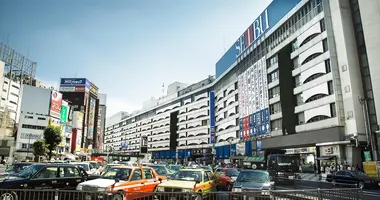Hanno 飯能市
- Published on : 20/12/2018
- by : I.D.O.
- Youtube
Between nature and manga
Located in the prefecture of Saitama, northwest of Tokyo, Hanno is ignored by tourist circuits. Wrongly, because this quiet town nestled in a mountainous setting opens onto an abundant nature that even inspired a manga.
Hanno was first a village that grew in importance during the Edo period (1603-1868) due to its proximity to the forest. As the future Tokyo boomed as the demand for timber intensified, Hanno became a town of lumberjacks . Wood cut in the surrounding forests was sent there as far as Edo via the Iruma River.
The city
During the Meiji era (1868-1912), Hanno annexed several surrounding villages and expanded considerably. It is now a quiet suburban town whose proximity to nature offers plenty of opportunities forhiking or picnicking by the water.
Odori Street , a short walk from the north exit of Seibu Hanno Station, is the city's old shopping street . If it does not shine by its aesthetics, it has a little retro side of the Showa years (1926-1989) which is not without charm. There are still some traditional buildings there, such as the Misegurakinujin. Built in 1904, it housed a silk store . Today, it hosts temporary exhibitions. The building itself is worthy of interest and has exhibited an admirable porcelain toilet dating from the Meiji era.
At the end of Odori Street, just after a crossroads, a road leads to the Naguri Valley (administratively attached to the city in 2005), a bucolic place known for its river along which locals but also Tokyoites go crowd on weekends and public holidays for picnics or barbecues. The river, Hanno-gawara, with its iconic red bridge, is only a 15-minute walk from Hanno Station.
At the very beginning of this route, the Kannon-ji temple is surprising. This charming temple founded in 810 belongs to the Chisan sect, one of the branches of esoteric Shingon Buddhism. If its buildings are typical of Japanese Buddhist temples , the statue of a white elephant is less so! The story says that during World War II, when Japan ran out of metal, the temple had to give away its bell to have it melted down. A local reportedly later donated a white elephant statue to replace it. This statue is therefore located in the structure traditionally housing the bell of a temple.
For kids
Getting off at Motokaji station, one can go to Akebono Tove Jansson Park ( Kodomo no Mori Kôen in Japanese), also known as Moomin Valley and Tove Jansson , the latter being the Finnish author of the Moomin children's books , to which the park refers. There are some strangely shaped buildings, bridges and a tree house that will delight the little ones.
To read: Opening of a Moomin park
Between nature and manga
Hanno being famous with manga fans (especially readers of the manga " Yama no susume ", not translated into French but which has been adapted into an anime for Japanese television and where the Kannon-ji temple appears), this elephant is the object of devotion on the part of readers! Similarly, the votive plaques ( ema ) which are traditionally decorated with a horse or animals of the Chinese zodiac here represent the white elephant or manga characters.
But the ties between manga and Hanno don't stop at Kannon-ji temple. To the north of the temple, a road leads to Chuo Koen, the Central Park, where is the statue of Astro the little robot (Tetsuwan Atomu in Japanese), the famous character of the no less famous manga-ka Tezuka Osamu . It is the only statue of the character that exists in the world. Next to it is a photo of Osamu Tezuka at the inauguration of the statue in 1983.
See also: The Osamu Tezuka Museum
Opposite the park, the Nonin-ji Zen temple, houses a magnificent garden created in the Momoyama era (1573-1603) and which has been named as one of the 100 most beautiful gardens in Japan . The temple was burnt down during the battle of Hanno (in 1868) but was rebuilt as originally a few years later. It is famous for its fall foliage .
Not far from the temple, many hiking trails allow you to enjoy this beautiful region. The closest is that of Tenran-zan. A mountain of only 195 meters above sea level. Just before its summit, the path splits in two. Following the path on the left, you reach the statues of 16 Rakan, which date from the Edo period. The Rakan were the first devotees of Buddha who attained enlightenment.
The other path leads to the top from where there is a splendid view of the Chichibu mountain range , Okutama and even on a clear day Tokyo and Mount Fuji. Other hiking trails lead to Mikaei-zaka and Mount Tonosu further west.
Special Feature: Mount Fuji Expedition
Hanno Festival
Every first weekend of November , Odori Street vibrates to the sound of traditional music that accompanies the carriers of mikoshi (portable shrines) during the Hanno festival.
Address, timetable & access
Address
Timetable
From Ikebukuro station (in Tokyo), take the Seibu line towards Chichibu and get off at Hanno station.Website
http://hanno-tourism.com.








































